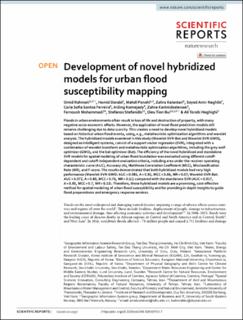| dc.contributor.author | Omid, Rahmati | |
| dc.contributor.author | Hamid, Darabi | |
| dc.contributor.author | Mahdi, Panahi | |
| dc.contributor.author | Zahra, Kalantari | |
| dc.contributor.author | Seyed Amir, Naghibi | |
| dc.contributor.author | Carla Sofia Santos, Ferreira | |
| dc.contributor.author | Aiding, Kornejady | |
| dc.contributor.author | Zahra, Karimidastenaei | |
| dc.contributor.author | Farnoush, Mohammadi | |
| dc.contributor.author | Stefanos, Stefanidis | |
| dc.contributor.author | Tien Bui, Dieu | |
| dc.contributor.author | Ali Torabi, Haghighi | |
| dc.date.accessioned | 2021-04-07T13:03:17Z | |
| dc.date.available | 2021-04-07T13:03:17Z | |
| dc.date.created | 2020-08-30T19:06:18Z | |
| dc.date.issued | 2020 | |
| dc.identifier.citation | Omid, R., Hamid, D., Mahdi, P., Zahra, K., Naghibi, S. A., Santos, F. C. S., ... & Haghighi, A. T. (2020). Development of novel hybridized models for urban flood susceptibility mapping. Scientific Reports, 10(1). | en_US |
| dc.identifier.issn | 2045-2322 | |
| dc.identifier.uri | https://hdl.handle.net/11250/2736675 | |
| dc.description.abstract | Floods in urban environments often result in loss of life and destruction of property, with many negative socio-economic effects. However, the application of most flood prediction models still remains challenging due to data scarcity. This creates a need to develop novel hybridized models based on historical urban flood events, using, e.g., metaheuristic optimization algorithms and wavelet analysis. The hybridized models examined in this study (Wavelet-SVR-Bat and Wavelet-SVR-GWO), designed as intelligent systems, consist of a support vector regression (SVR), integrated with a combination of wavelet transform and metaheuristic optimization algorithms, including the grey wolf optimizer (GWO), and the bat optimizer (Bat). The efficiency of the novel hybridized and standalone SVR models for spatial modeling of urban flood inundation was evaluated using different cutoff-dependent and cutoff-independent evaluation criteria, including area under the receiver operating characteristic curve (AUC), Accuracy (A), Matthews Correlation Coefficient (MCC), Misclassification Rate (MR), and F-score. The results demonstrated that both hybridized models had very high performance (Wavelet-SVR-GWO: AUC = 0.981, A = 0.92, MCC = 0.86, MR = 0.07; Wavelet-SVR-Bat: AUC = 0.972, A = 0.88, MCC = 0.76, MR = 0.11) compared with the standalone SVR (AUC = 0.917, A = 0.85, MCC = 0.7, MR = 0.15). Therefore, these hybridized models are a promising, cost-effective method for spatial modeling of urban flood susceptibility and for providing in-depth insights to guide flood preparedness and emergency response services. | en_US |
| dc.language.iso | eng | en_US |
| dc.relation.uri | https://www.nature.com/articles/s41598-020-69703-7 | |
| dc.rights | Navngivelse 4.0 Internasjonal | * |
| dc.rights.uri | http://creativecommons.org/licenses/by/4.0/deed.no | * |
| dc.title | Development of novel hybridized models for urban flood susceptibility mapping | en_US |
| dc.type | Peer reviewed | en_US |
| dc.type | Journal article | en_US |
| dc.description.version | publishedVersion | en_US |
| dc.rights.holder | © The Author(s). | en_US |
| dc.source.volume | 10 | en_US |
| dc.source.journal | Scientific Reports | en_US |
| dc.identifier.doi | https://doi.org/10.1038/s41598-020-69703-7 | |
| dc.identifier.cristin | 1826077 | |
| dc.source.articlenumber | 12937 | en_US |
| cristin.ispublished | true | |
| cristin.fulltext | original | |
| cristin.qualitycode | 1 | |

